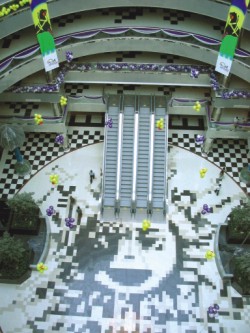| Economy
The Economics of Luxury
Luxury consumers have long been chided for
making “irrational” choices in the market. But do
luxury products really make us a freak of economic nature?
Faruq Hasan
Have you ever bought a high-end cell phone that promises a mini laptop in your hands, only to end up using it for calls and texts? Or perhaps you know of a friend who spends half her salary buying a saree that she is going to wear once a lifetime? Or maybe you go to restaurants that have servings the size of your fist but charge you considerably more for alleged gastronomical delights? Well, you're not the only one. Welcome to the world of luxury goods, a market segment that has been growing rapidly despite the financial crisis, a realm that has its own laws and rituals that has some conventional economists scratching their heads.
Luxury products are, by definition, products that are financially out of reach for the mainstream population; in fact, most suppliers of luxury goods would tell you that the luxury goods market appeals to less than 2% of any population. The statistic should make sense; after all, a product loses its luxury appeal if it's available to the mass consumer. The reality is a bit more complex. The market for luxury products is ever changing and transitory mainly due to two factors: taste and economic viability. 
Take taste for example. Wearing (real) fur coats and donning crocodile handbags may still be considered chic in most of Eastern Europe, but try doing the same thing in Nordic countries and you're bound to be a social pariah. Economic viability, or consumer disposal income to be more specific, along with local availability, also dictate what get delegated as luxury products. Caviar (which is basically fish eggs) is synonymous with luxury in large parts of the West, but try telling a Bangladeshi that her favourite Ilish macher dim will now sell for Tk 5000/lb and she will probably laugh in your face.
Thus the definition may be culturally dependent and hinging on local market factors and income, but essentially luxury products and markets operate in similar ways: they appeal to the very exclusive and serve as market niches. And it's not only the middle-aged who are joining the luxury bandwagon. Increasingly, young people are extremely brand conscious. What exactly is going on?
The answer is quite simple: more young people now have money than ever before. You only need to roam around the exclusive boutiques or expensive laptop showrooms of Dhaka to see a burgeoning upper-middle class who don't think twice about purchasing something that was out of their reach even five years back. And most of the people who are swiping their credit cards are not professionals in their late thirties but students and young entrepreneurs in the mid to late twenties.
The demographics of the luxury market have clearly shifted and this is clearly influencing advertising and marketing campaigns as well. Marketing companies are increasingly using younger models in their advertising campaigns, while companies are trying to come up with exclusive products that appeal to the younger population without losing their chic appeal. Take the business mobile phone for example. Previously both a cachet and utility device for strictly professionals high up in the company hierarchy, they are now increasingly sported by young university students who use them to connect to social networking websites like Facebook and blogs or downloading the latest song or television serial from the Internet. Clearly spending power of the young has increased manifold; even a modest business phone can set you back around Tk 35,000.
This increase in demand for luxury products, especially amongst the young, poses an interesting question for both marketing and design people. How can you retain your exclusivity while broadening the appeal for your product at the same time? In other words, will a Gucci handbag lose its appeal if your office secretary starts sporting one too? The answer may lie in what economists call market segregation: creating sub-branches of the same product that cater to different consumers with different incomes, but at the same time excluding one market seeping into the other.
Take the market for mp3 players which Apple has pretty much dominated and chalked itself out as an exclusive product. Apple essentially sells the same products (a music player that plays audio files) as its competitors, but develops different hardware for essentially the same software. Thus the iPod Touch caters to a slightly more selective audience (and hence a higher price tag) than the regular with a slight adjustment in the interface, while essentially keeping the same features (playing music and video files). Users of both products are happy because they are both using apple products that set them aside from the more generic brands. And Apple is happy because they have tapped into both markets without compromising its brand identity in anyway.
But the puzzle that economists are stumped by most is why the financial crisis has not really dented the demand for luxury products significantly. After all, when you're short on cash, shouldn't luxury goods be the first one that go out off your list? There are two answers to the question. One is more and more countries are joining the luxury bandwagon which was strictly the domain of a few western nations. The appetite for luxury products is growing on a daily basis in the so called BRIC countries (Brazil, Russia, India and China) that have recently been awash with high incomes from rising oil and commodity prices. Decades of poverty has whet the hunger for joining the elite even more, and the allures of the rich, something which many had only seen on television, are very much in the grasp of many.
The second answer does not lie strictly in the domain of conventional economists, but in range of studies of a new group of economists who call themselves behavioural economists. Such economists have pointed out the emotional basis of consumerism: that sometimes we buy products mostly to satisfy an emotional need. Analyzed with such a lens, luxury products fulfil our craving for status and recognition. Thus when we buy a Polo shirt or drink Evian mineral water not because they give us a significant edge in terms of quality, but because they help us break from the herd and confer uniqueness on us. The last feature alone should serve a warning to future purveyors of luxury products: luxury consumers are a fickle lot as they are always on the lookout for the next product that will make them “special”. So much for buying brand loyalty!
Faruq Hasan is a Communications Officer, DFID Shiree, Bangladesh.
Copyright (R) thedailystar.net 2008
|
